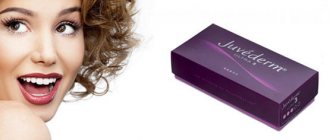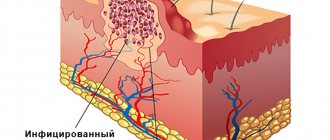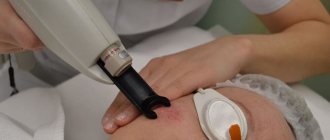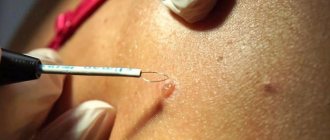Author
Kulova Zhanna Borisovna
Head of the Center for Cosmetology and Preventive Medicine
Cosmetologist
until January 31
We are giving away 1000 rubles for all services for a visit in January More details All promotions
Cryodestruction is a method of removing tumors on the skin, which is based on the use of liquid nitrogen. Often considered as a tool in aesthetic cosmetology and dermatology, allowing you to get rid of:
- warts;
- papillomas;
- condylomas;
- keratome;
- hemangiomas;
- unwanted moles (nevi).
This method is successfully used in other branches of medicine - gynecology, surgery, oncology. The method of cryodestruction successfully removes tonsils and treats cervical erosion. Using endoscopic methods, doctors have learned to use cryodestruction to combat tumors of internal organs.
What is cryodestruction?
Cryodestruction is a procedure for removing pathological tissue using cryogenic or a special freezing mixture. Nitrogen cooled to -195.75°C is used in cosmetology for this purpose. In this state, it acquires a liquid consistency. The substance is stored in special portable cylinders to which a micro-applicator is connected. The microapplicator is equipped with special attachments that provide a targeted effect of cryogen on pathological areas without affecting healthy tissue.
Advantages and disadvantages of liquid nitrogen removal:
Important: Benefits:
- No anesthesia required (no need to give an injection)
- The method can be used repeatedly on the same tumor
- No bleeding after removal
- Rarely leaves scars
- Good results for small pedunculated formations (papillomas)
Flaws:
- You cannot take a biopsy (microscopic analysis) of a remote lesion
- The need for repeated use of liquid nitrogen, especially for large tumors and located in areas with a thick layer of epidermis (on the palms and soles).
How is the procedure done?
No preliminary preparation for the procedure is required. For most patients, the procedure is painless, but if the pain threshold is low, the doctor may perform local anesthesia or the patient may take an anesthetic an hour before the procedure.
To carry out cryodestruction, the doctor, depending on the size of the tumor, uses a cryodestruction apparatus or an applicator pre-moistened in liquid nitrogen. With these attachments he cauterizes the tumor. The doctor determines the exposure time and number of touches individually for each patient.
After the procedure, a mark resembling a burn remains on the skin, so the area may be painful during the healing period, which lasts from 7-10 days to 3 weeks. After the procedure, the wound should be wiped with a disinfectant. It is impossible to pierce the serous vesicle or remove the scab of skin that then forms at the site of the wound, so as not to infect it. After some time it will disappear on its own. A soft pink new skin forms in place.
To remove small formations, one session of cryodestruction is often sufficient; to remove large formations, several sessions will be required.
Indications for cryodestruction
Cryodestruction with liquid nitrogen is indicated for various pathologies that are infectious in nature or related to skin defects. The most common is cryodestruction of warts. This method is widely used to remove various neoplasms of pigmented or vascular type: nevi, hemangiomas, papillomas, condylomas, pigmentary granulomas, hyperkeratosis, squamous cell carcinoma, epidermal cyst, melanoma, mastocytoma.
Cryodestruction with liquid nitrogen is widely used in gynecology for cervical erosion, condylomas and papillomas of the vagina and vulva, ectopia of columnar epithelium, cervical dysplasia, cervical leukoplakia and other gynecological diseases.
Benefits of cryodestruction
- The procedure is performed on an outpatient basis and does not require hospitalization of the patient.
- After removal, there are no scars or scars left on the skin, so we can talk about an impeccable cosmetic effect.
- Cryodestruction can be performed on all categories of patients, including the elderly, pregnant women and children.
- Cauterization can be performed on any part of the body, including areas with thin, sensitive skin.
- With proper postoperative care and following the doctor's recommendations, the risk of complications is minimal.
- Quick implementation, session time does not exceed 2-7 minutes. The duration of the manipulation depends on the size of the formation.
- Short rehabilitation period.
Removal of neoplasms with liquid nitrogen
Removing tumors with liquid nitrogen is a time-tested, effective treatment method. Many patients often perceive tumors as cosmetic problems on the skin, rather than as a disease, and turn to a doctor late for help. Benign epithelial skin tumors differ in size, color, number, location, but they are more often of a viral nature or associated with self-medication. So, many patients bandage skin tumors with female or horse hair, trim them with nail scissors, etc. This does not solve the problem, but creates an environment for a secondary infection to occur. Injured tumors grow faster, disturb the owner, become wet, bleed, become crusty, and are painful. It is much easier to see a doctor without self-medication
Contraindications for cryodestruction
- Individual high sensitivity to cold.
- Acute respiratory, viral or infectious diseases.
- High body temperature.
- Exacerbation of chronic diseases.
The procedure cannot be performed unless the nature of the neoplasm is clear and tissue samples must be taken for examination. Also, cryodestruction is not used to remove large tumors, as well as those located in hard-to-reach places.
Cryodestruction is a safe, easy-to-perform and very effective procedure for removing skin tumors. It takes minimal time, but requires some time for the wound to heal. The medical center provides high-quality removal of various skin tumors using modern equipment for cryodestruction. You can make an appointment with a specialist by calling: 8 812 313-21-13.
How is papillomas removed by cryodestruction?
A few seconds of exposure to liquid nitrogen is enough for the neoplasm to collapse
Using the example of papilloma, we will look at how the procedure for removing a tumor with liquid nitrogen is carried out. The process can be divided into the following stages:
1. Freezing papilloma. Using a special device or miniature applicator, the doctor applies liquid nitrogen with a temperature of –195.7 degrees Celsius to the tumor.
2. Necrosis of papilloma. Under the influence of liquid nitrogen, the pathological area turns pale, the patient begins to feel a slight tingling: this is the crystallization of the cytoplasm in the neoplasm cells, which damages their membranes. The time allotted for the procedure (from 5 to 30 seconds) is quite enough to cause irreparable damage to the papilloma.
3. Restoration of blood circulation. Within a few hours after the procedure, the area of skin where the papilloma was located turns red and swells.
4. Complete necrosis of papilloma. The process takes from 2 weeks to 2 months. From the neoplasm itself, only a crust remains, and healthy, smooth tissue forms under it.
5. Recovery. After a maximum of six months, there will be no traces left on the skin.
If the papilloma was large enough, the procedure may need to be repeated. In this case, only a doctor can give the exact timing of the final solution to the problem.
If after cryotherapy a bubble with liquid appears at the site of the tumor, it is not recommended to pierce it. It is better to treat the skin area with an antiseptic until this bubble disappears naturally, or consult a dermatologist for advice.
Complications and side effects of cryodestruction
There are practically no complications with cryodestruction. Scarring or pigmentation of the skin at the site of freezing can rarely be observed, which is more typical for dark-skinned people or those who often sunbathe a lot. This problem may go away on its own after a few months.
Among the side effects of freezing papillomas are the appearance of blisters if the neoplasm is large, which go away on their own over time, as well as swelling of the tissue around the papilloma.
The tissue swells due to the process of activating the human immune system, and this goes away in a couple of days without any medical intervention. To avoid complications, you need to prepare for cryofreezing in advance and follow all doctor’s instructions after the procedure.
Dermatologists
- Ayvazyan Linda Volodyevna
Experience: 5 yearsDermatovenerologist, mycologist, trichologist
Rating: 0/5 — 0 votes
Make an appointment
- Osipova Daria Sergeevna
Experience: 14 years
Deputy chief physician for medical work. Dermatovenerologist
Rating: 0/5 — 0 votes
Make an appointment
The cryodestruction method is widely used in dermatology to remove various skin tumors. This is a modern, effective way to correct cosmetic defects and treat diseases. Cryodestruction can remove warts, moles, basal cell carcinomas, papillomas, condylomas, scars, old calluses and other undesirable phenomena from the skin. There are practically no traces left.
At the Kutuzovsky Children's Center, cryodestruction treatment is performed by experienced dermatologists. The procedure is performed on an outpatient basis in our clinic in Moscow. Prices for cryodestruction are indicated on the website.
Patient's condition after the procedure
Most patients experience no complications after cryodestruction; the manipulation is well tolerated by patients. Wound healing after cryodestruction occurs according to the type of aseptic exudative inflammation. This explains the fact that on the first day after surgery, body temperature may rise to subfebrile levels (37-37.2 degrees).
Pain in the throat may last 3-4 days. The maximum pain disappears within the first day. Every other day, a gray coating may appear, which disappears in 5-10 days.
If pain occurs at the site of exposure, the patient is usually prescribed painkillers, taking into account individual tolerance.
Advantages of the method
During cryodestruction there is no mechanical impact on the formation. The skin next to the defect remains undamaged.
The cryodestruction procedure involves exposing the formation to liquid nitrogen. Pathological cells freeze and are destroyed. In the area of exposure to cold, a bubble forms, then a crust, under which active tissue healing occurs. After a few weeks it goes away without leaving a scar.
Treatment is not accompanied by bleeding. Cryodestruction of tumors is often performed even without local anesthesia. No preparation is required either.
Other benefits of the procedure:
- Quick removal of defects.
- High efficiency against formations of various natures.
- Removal of malignant processes without surgery, for example, cryodestruction of basal cell carcinoma.
- Visible results after one session.
- Outpatient treatment – the patient leaves the clinic immediately after the procedure.
- Short rehabilitation period.
- No need for special care of the crust.
- Affordable prices compared to other destruction methods.
Removal of papillomas with liquid nitrogen in Moscow: features of the technique
Cryodestruction is the removal of skin lesions using liquid nitrogen. Why do we use this particular method? The fact is that nitrogen is a component of atmospheric air. In order to remove papillomas using cryodestruction, it is necessary to obtain liquid. Nitrogen changes from gaseous to liquid at a temperature of 200C. The technological process is quite simple and proven: nitrogen needs to be cooled, converted into a liquid state, in which the substance is poured into flasks and stored under certain conditions.
Complications
There are practically no complications during cryoprocedures. Possible complications are mainly associated with an individual reaction to cold exposure (severe swelling of surrounding tissues) and the addition of infectious diseases in case of contact with a patient with an acute respiratory infection.
On a note! Specialists at the Lor Plus clinic have been providing cold treatment for decades. The accumulated experience in combination with modern diagnostic and treatment equipment allows us to assert that cryotherapy treatment is very effective for a number of ENT diseases, is practically painless and takes a few minutes. Cryotherapy today is perhaps the only method that allows one to avoid surgical treatment and at the same time preserve the functions of the ENT organs.
Make an appointment
Indications for cryodestruction
The development of papillomas occurs due to the activation of the human papillomavirus after contact with objects contaminated with it. Depending on the type of virus, neoplasms may also differ from each other. Sometimes papillomas appear, sometimes warts, sometimes growths or condylomas.
The need to remove the tumor is determined by a surgeon, gynecologist, oncologist or dermatologist. Typically, there is such a need if there is a risk or actual violation of the integrity of the neoplasm, the woman is taking hormonal contraceptives, the patient has reduced immunity, the person drinks or smokes, and the area under the tumor is dangerous for injury. The patient may also complain to the doctor about discomfort from “wearing” the papilloma, and this will also be a reason for its removal.
Among the main contraindications for cryodestruction are acute infections, inflammation in the internal organs of a person, cold intolerance, and the possibility of an oncopathological basis for the neoplasm.
Contraindications
- Decompensated diabetes mellitus;
- Pregnancy and breastfeeding;
- Diseases associated with blood clotting disorders;
- Uncompensated connective tissue diseases;
- History of anaphylactic shock (the decision is made individually);
- History of cancer;
- Vascular diseases which are based on the processes of their spasm (narrowing);
- Severe pigmentation of the skin;
- Some types of anemia (eg, cold hemolytic anemia);
- History of cold urticaria;
- Tendency to form keloid scars.
Cryodestruction technique
During cryodestruction, only two methods of deep local cooling of pathological tissues are fundamentally possible: direct exposure of the tissue to liquid nitrogen or freezing with an applicator (metal tip), which is actively or passively cooled by liquid nitrogen. However, there are many variations of these methods. The choice of the optimal method of cryotherapy is made by an ENT doctor at an appointment, after a thorough examination of the patient, as well as conducting the necessary clinical examinations.
As a general rule, the time required for cryotherapy is determined by the nature and severity of the pathological process at the site of exposure.
During cryodestruction, freezing can be performed using the one- or two-cycle method. Usually a single cycle (one-time) exposure is sufficient. However, with a common pathological process, a two-cycle effect is sometimes used. In this case, tissues are re-frozen 10-15 minutes after the first one. This technique enhances the destruction of underlying (underlying) tissues and subsequently leads to a good clinical effect.
Who should not undergo cryodestruction?
Despite the fact that cryodestruction is a minimally invasive operation, the effect is targeted and no scars remain after healing, the procedure has a number of contraindications.
Conditions in which cryodestruction is not performed:
- pregnancy;
- menstruation;
- inflammatory diseases of the pelvic organs;
- cicatricial deformation of the cervix;
- advanced endometriosis;
- fibroids requiring surgical removal;
- malignant neoplasms on the cervix;
- the boundaries of the affected areas are poorly defined or the erosion is large.
Not all cervical erosion requires treatment. If several doctors agree and strongly recommend undergoing surgical treatment, do not put off solving the problem indefinitely, risking facing dysplasia or more serious problems. It is faster and easier to get rid of any disease when it is at an early stage!
Find out the prices and sign up for cryodestruction of the cervix in one click!
The use of cryotherapy for various diseases
Cold treatment is effective for many diseases of the ENT organs:
- chronic tonsillitis,
- recurrent nosebleeds from the nasal septum,
- vasomotor rhinitis,
- hypertrophy of the palatine tonsils,
- chronic hypertrophic pharyngitis,
- benign neoplasms of the nasal cavity, pharynx,
- skin diseases of the external nose and ears.
The most important thing is that there are practically no contraindications for cold treatment (except for acute inflammatory processes), and in some cases it is even carried out for pregnant women.
Rehabilitation: skin care after cryodestruction
- Do not allow the treated area to come into contact with clothing to avoid damaging the protective film.
- Do not cover with adhesive tape so as not to disturb air exchange. It is acceptable to cover with a gauze bandage.
- Do not puncture the blister. If its integrity is compromised, an infection may enter the wound, and a scar will form in its place after healing.
- Do not peel off the crust so that a scar does not appear.
- You can take a shower, but you cannot rub or steam the treatment area.
- Use healing ointments as prescribed by a doctor. They will speed up the healing of the skin after cryodestruction and prevent complications.










